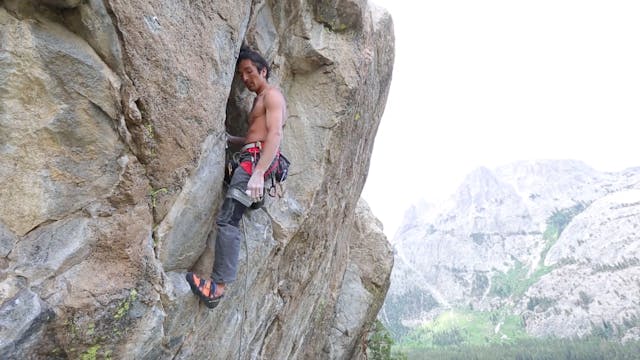Sport Climbing: 10. Successful Projecting
Sport Climbing
•
3m 52s
In this video we review the definition of, and considerations for, successful projecting.
On-sighting a route is one of the most gratifying achievements of rock climbing. This is when a climber “sends” a route on their first try, without any “beta” or information about the route. This can be a challenge and even the best climbers have a hard time sending routes their first time.
Projecting routes, or projecting, is when a climber works a climb of a higher difficulty grade (i.e. 5.11) than their onsight skill level (i.e. 5.10), in an effort to break into the next level of their climbing.
If the climber fails their onsight attempt, they may continue to work the route as many times as necessary to send it. Below are a few considerations for successful projecting:
1. Break the route down into individual pieces, sections, bouldery cruxes, or even individual moves.
2. Try to hang a top rope on the route and suss out the movement and the cruxes.
3. At especially hard sequences or moves, try clipping in directly to bolts with a draw (while still on belay—this helps reduce strain on your belayer) and visually explore your options.
4. After a fall, take a good rest. Hang, shake out, and relax. Get your head back in the game, place your feet and hands on the wall, and yell “Climbing!” to your belayer so they know to give you slack and let you climb again.
5. After a fall, the leader will need to ascend back to their last position or bolt in order to try again. If the route is not too steep, they can climb back up or bat man up the rope. If it is fully overhanging and the climber is hanging in mid-air, they will need to “boink” into position.
- Batmanning is where the climber grabs the belay strand of the rope and pulls down while the belayer counterweights the rope and takes in slack, thus making the climber ascend. For this method, the climber must be able to reach the belay strand—that is, the rope that runs through the last quickdraw and back to the belayer.
- When the climber is on such a steep route that they end up hanging in mid air after falling, they can use the “boinking” technique. This is where the climber grabs the rope at arm’s length from their tie-in, does a pull up and then lets go. The belayer is also weighting the rope, such that in an instant of weightlessness, their weight takes in some slack. Several repetitions and the climber will be within reach of the wall again!
6. Get the route wired and dialed so you know the moves, hard sections, rests, stances, and clipping positions. When you feel you know the route well, and can climb the individual sections, try linking larger parts of the climb—and eventually the whole thing!
7. When you have the route dialed, go for the send. If you fail, take a long rest, 30 min to an hour. Rest, stretch, meditate—whatever it takes to get ready for your next attempt.
8. A positive mental attitude goes a long way! If you are having problems with a certain move or sequence, keep your internal dialogue positive and open-minded.
9. Approach each attempt as a learning opportunity. Sometimes all it takes is a slight change of foot, hand, or body positioning.
10. Focus on mindful breathing. Even exaggerated breathing can help force you into a rhythmic pattern.
11. If you’re stuck, maybe try something out of the ordinary. Keep an open mind and let the rock speak to you.
12. When in doubt…give it your all: scream, yell, grunt—whatever it takes! Vocalizations can even help engage your core muscles.
We hope you found this video helpful. Feel free to comment below with questions or thoughts!
Please remember, climbing is inherently dangerous. Climb at your own risk.
Up Next in Sport Climbing
-
Sport Climbing: 11. Resting on Routes
In this video we review the importance of resting on routes.
While on a long route, it is important to:
- Look for large holds or stances where you can relax your body, and catch a rest.
- Use straight-arm techniques to hang on your skeletal system, as opposed to pulling with your muscl...
